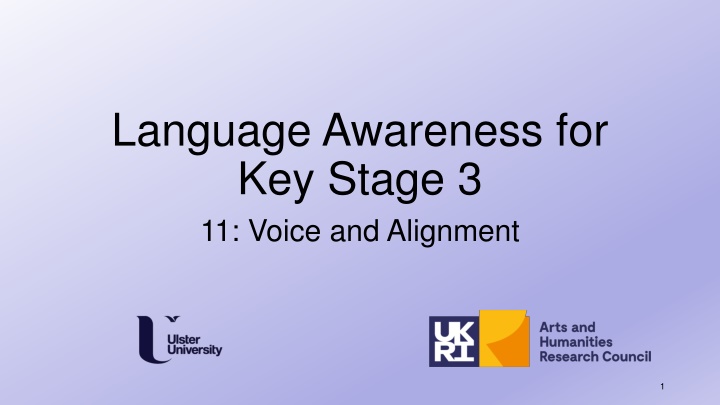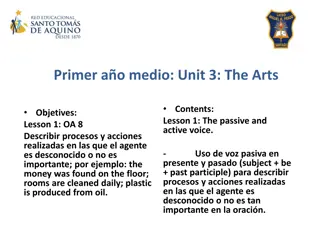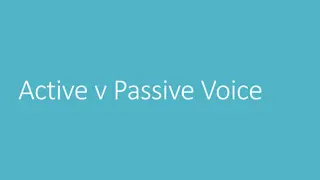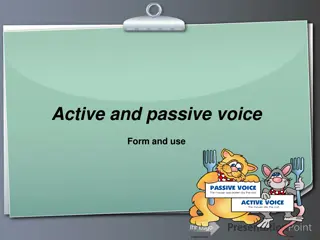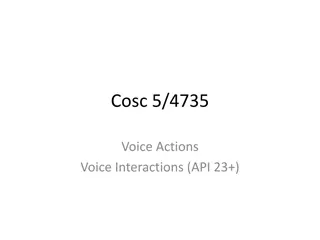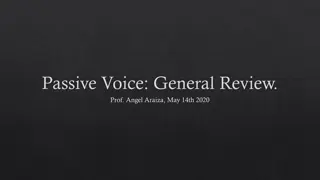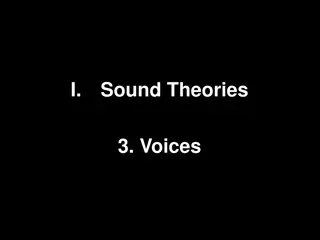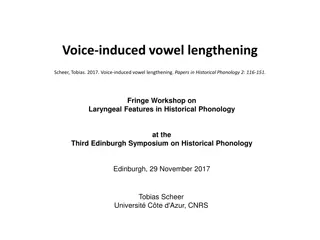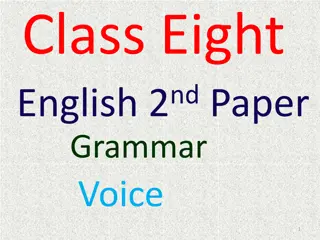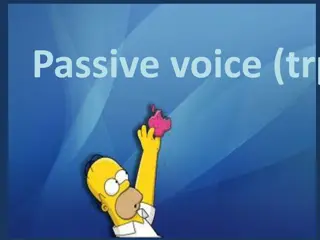Voice in Language
Concept of voice in language through the lenses of active and passive voices, agents and patients, and subject-object relationships. Discover how participants are assigned roles in sentences and the implications of active versus passive voice constructions.
Uploaded on Feb 17, 2025 | 0 Views
Download Presentation

Please find below an Image/Link to download the presentation.
The content on the website is provided AS IS for your information and personal use only. It may not be sold, licensed, or shared on other websites without obtaining consent from the author.If you encounter any issues during the download, it is possible that the publisher has removed the file from their server.
You are allowed to download the files provided on this website for personal or commercial use, subject to the condition that they are used lawfully. All files are the property of their respective owners.
The content on the website is provided AS IS for your information and personal use only. It may not be sold, licensed, or shared on other websites without obtaining consent from the author.
E N D
Presentation Transcript
Language Awareness for Key Stage 3 11: Voice and Alignment 1
Roadmap Today we will look at another property that verbs can have: voice We will look at the active and passive voices, as well as the middle voice We will see different ways of forming the voices, and the different auxiliaries that can be used For those who want an extra challenge, there is an appendix about languages with ergative alignment and how voice works in them 2
Voice To understand how voice works, it may be useful to start by reviewing the categories of subject and object 1. Jack killed the giant 2. Mary built a boat In these sentences, Jack and Mary are the subjects The subject is the word that normally comes before the verb in English The giant and a boat are the objects The object is the word that normally comes after the verb in English 3
Voice Another way of thinking about these sentences is in terms of agents and patients 1. Jack killed the giant 2. Mary built a boat In these sentences, Jack and Mary are the agents The agent is the one doing something, like killing or building The giant and a boat are the patients The patient is the one having something done to it 4
Voice Voice has to do with how participants such as agents and patients are assigned to the categories of subject and object 3. Jack killed the giant 4. The giant was killed by Jack Sentence (3) is in the active voice The one killing is the subject, and the one being killed is the object Sentence (4) is in the passive voice The one being killed is now the subject Note that the one killing does not become the object 5
Voice Voice has to do with how participants such as agents and patients are assigned to the categories of subject and object 3. Jack killed the giant 4. The giant was killed by Jack In the active voice, the subject is the agent and the object is the patient In the passive voice, the subject is the patient and the agent is introduced by a preposition 6
Voice Voice gives you different ways of describing the same thing One use for voice is to change the focus of the sentence There is usually more focus on the subject than on the object 5. Jack killed the giant This looks like a sentence about Jack 6. The giant was killed by Jack This looks like a sentence about the giant 7
Voice Another benefit of having different voices is for when you don t know or don t care who the agent is In that case, you can simply leave the agent out 7. The giant was killed by Jack 8
Voice Another benefit of having different voices is for when you don t know or don t care who the agent is In that case, you can simply leave the agent out 7. The giant was killed 9
Activity Take some time to think about the active and passive voices Which do you think you use most often? When would you be most likely to use a passive sentence? 10
Voice In English, passives are formed using the auxiliary be and a participle (e.g. seen) Many languages form passives the same way 8. Fueron vistos (They) were seen Some languages use other auxiliaries 9. Sie wurden gesehen They were seen (literally, They became seen ) In other languages, passive verbs are a single word 10. phth san (They) were seen (Spanish) (German) (Greek) 11
Voice Sometimes languages have more than one auxiliary that they can use for the passive In English you can form passives with get as well as be 11.I was sent a letter 12.I got sent a letter German does something similar, using bekommen get 13.Ich bekam ein Brief geschickt 12
Voice So far, we have looked at the active and passive voices In the active voice, the subject is the agent In the passive voice, the subject is the patient 13
Voice However, active and passive aren t the only possible voices Some languages also have a middle voice The meaning of the middle voice is hard to describe, but it usually indicates that the subject is more than usually affected by an action 14
Voice It may be easiest to see how the middle voice works in a language like Greek, which has special middle forms 14.I nn s n zei t n tr pezan John washes the table 15.I nn s n zetai John washes (washes himself) 16.I nn s n zetai hup to hueto John is washed by the rain You can see that the meaning of the middle overlaps with the active and passive active middle (like active) middle (like passive) 15
Voice Greek is not the only language that has a middle voice The term middle is sometimes applied to English sentences where the verb has an active form without the usual active meaning 16.Mary photographs well (= When Mary is photographed, it turns out well ) 17.These tiles clean easily (= These tiles can be cleaned easily ) Note that the results in each case have more to do with Mary and the tiles than the photographer or the cleaner 16
Voice Pronominal verbs in Romance languages such as French are also very similar to the middle forms seen in Greek 18.Marie se lave Mary washes herself 19.La table se lave The table gets washed (literally, The table washes itself ) However, Greek is different from English and French in having special forms used just for the middle voice 17
Activity Some of you may know languages other than the ones that we ve discussed here Take some time to see which voices these languages have You can start by trying to translate some of the sentences we ve seen How many of the languages use auxiliaries for voices? Can you find any voices we haven t looked at yet? 18
Voice Passive verbs let you talk about events without mentioning the agent The passive voice is not the only way to do this 20.John broke the window 21.The window was broken 22.The window broke In (22), the verb broke is in the active voice However, it is intransitive 19
Voice Transitive verbs are verbs that have an object 23.John made a mistake Intransitive verbs are verbs with no object 24.Mary arrived Some verbs are always transitive or always intransitive Other verbs, such as break, can be either Only transitive verbs have a passive voice 25.Mary got arrived 20
Voice When you use the passive voice of a transitive verb, the agent is still there, even when you don t express it 26.The window was broken on purpose (Someone meant to break the window) However, when you use an intransitive verb, the agent isn t there at all 27.The window broke on purpose (The window meant to break) 21
Summary Today we have see how the same verb can occur in different voices We have looked at the active, middle, and passive voices We have seen that passives and middles can take many different forms We have also seen the similarities and differences between passives and intransitive verbs If you want an extra challenge, you can keep going to see some very different types of voice 22
Appendix Alignment 23
Alignment In some languages, voice and case work very differently from what we ve seen so far 24
Alignment To understand this, a useful beginning may be to review how case works in English 28.He returned 29.He saw her 30.She was seen by him Return is an intransitive verb: it doesn t have an object See is a transitive verb: it does have an object Because see is transitive, it has a passive, where the object becomes a subject 25
Alignment To understand this, a useful beginning may be to review how case works in English 28.He returned 29.He saw her 30.She was seen by him He and she are in the nominative case The nominative case is used for all subjects, of transitive and intransitive verbs Him and her are in the accusative case The accusative case is used for objects, as well as for the agents of passive verbs 26
Alignment You can see quite a different pattern in a language like Dyirbal (an Aboriginal language of Australia) 31.Bayi banaganyu He returned 32.Balan banaganyu She returned 33.Ba gul buran balan He saw her 34.Ba gun buran bayi She saw him 27
Activity Take a minute to look at these examples. Can you describe what the rules are for which form to use? 31.Bayi banaganyu He returned 32.Balan banaganyu She returned 33.Ba gul buran balan He saw her 34.Ba gun buran bayi She saw him 28
Alignment 31.Bayi banaganyu He returned 32.Balan banaganyu She returned 33.Ba gul buran balan He saw her 34.Ba gun buran bayi She saw him Ba gul he and ba gun she can only be used as the subject of transitive verbs 29
Alignment 31.Bayi banaganyu He returned 32.Balan banaganyu She returned 33.Ba gul buran balan He saw her 34.Ba gun buran bayi She saw him For the subject of intransitive verbs, you need different forms, bayi and balan 30
Alignment 31.Bayi banaganyu He returned 32.Balan banaganyu She returned 33.Ba gul buran balan He saw her 34.Ba gun buran bayi She saw him Bayi and balan are also used for the objects of transitive verbs, where we say him and her 31
Alignment 31.Bayi banaganyu He returned 32.Balan banaganyu She returned 33.Ba gul buran balan He saw her 34.Ba gun buran bayi She saw him Bayi and balan are in the absolutive case, and ba gul and ba gun are in the ergative case 32
Alignment A language like Dyirbal, which has an ergative case, is said to have ergative alignment A language like English, which has an accusative case, is said to have accusative alignment 33
Alignment This property is called alignment because it relates to how the cases line up with different verbs English him/her Dyirbal Object of transitive verb (e.g. see) Subject of intransitive verb (e.g. return) Subject of transitive verb (e.g. see) bayi/balan he/she ba gul/ba gun 34
Alignment Other languages with ergative alignment: Basque (spoken in parts of France and Spain) Greenlandic (spoken in Greenland) Yucatec (spoken in Mexico) Some languages even have a mix of ergative and accusative alignment One split ergative language is Hindi 35
Alignment Many languages with ergative alignment have an antipassive voice 35.Ba gul buran balan He saw her 36.Bayi bural anyu bagun He was looking at her The verb buran is in the active voice It has an ergative subject and an absolutive direct object The verb bural anyu is in the antipassive voice It has an absolutive subject and a dative indirect object Remember that the dative case is the one used for meanings like to her or at her 36
Alignment The exact sense of the antipassive can be difficult to translate into English Like the passive in English, it provides a different way of describing the same situation, letting people choose what to emphasise and how to structure what they say 37
Conclusion We have seen that alignment has to do with how a language treats the subjects of intransitive verbs Languages with accusative alignment have nominative and accusative cases Languages with ergative alignment have ergative and absolutive cases Ergative languages can have a special antipassive voice 38
